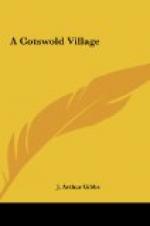The same clergyman knew an old Cotswold labourer who wished to get rid of the evil influence of the devil. So Hodge wrote a polite, though firm, epistle, telling his Satanic Majesty he would have no more to do with him. On being asked where he posted his letter, he replied: “A’ dug a hole i’ the ground, and popped un in there. He got it right enough, for he’s left me alone from that day to this.”
The Cotswold people are, like their country, healthy, bright, clean, and old-fashioned; and the more educated and refined a man may happen to be, the more in touch he will be with them—not because the peasants are educated and refined, so much as because they are not half-educated and half-refined, but simple, honest, god-fearing folk, who mind their own business and have not sought out many inventions. I am referring now to the labourers, because the farmers are a totally different class of men. The latter are on the whole an excellent type of what John Bull ought to be. The labouring class, however, still maintain the old characteristics. A primitive people, as often as not they are “nature’s gentlemen.”
In the simple matter of dress there is a striking resemblance between the garb of these country people and that of the highly educated and refined. It is an acknowledged principle, or rather, I should say, an unwritten law, in these days—at all events as far as men are concerned—that to be well dressed all that is required of us is not to be badly dressed. Simplicity is a sine qua non; and we are further required to abstain from showing bad taste in the choice of shades and colours, and to wear nothing that does not serve a purpose. To simple country folk all these things come by nature. They never trouble their heads about what clothes they shall wear. The result is, the eye is seldom offended in old-fashioned country places by the latest inventions of tailors and hatters and the ridiculous changes of fashion in which the greater part of the civilised world is wont to delight. Here are to be seen no hideous “checks,” but plain, honest clothes of corduroy or rough cloth in natural colours; no absurd little curly “billycocks,” but good, strong broad-brimmed hats of black beaver in winter to keep off the rain, and of white straw in summer to keep off the heat. No white satin ties, which always look dirty, such as one sees in London and other great towns, but broad, old-fashioned scarves of many colours or of blue “birdseye” mellowed by age. The fact is that simplicity—the very essence of good taste—is apparent only in the garments of the best-dressed and the poorest-dressed people in England. This is one more proof of the truth of the old saying, “Simplicity is nature’s first step, and the last of art.”
The greatest character we ever possessed in the village was undoubtedly Tom Peregrine, the keeper.
“A man, take him
for all in all,
I shall not look
upon his like again.”




